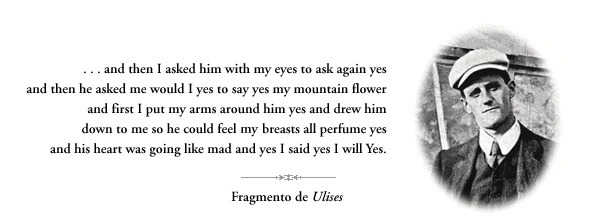
James Joyce. I INTRODUCTION James Joyce (1882-1941), Irish author, whose writings feature revolutionary innovations in prose techniques. He was one of the foremost literary figures of the 20th century. Joyce is best known for his epic novel Ulysses (1922), which uses stream of consciousness, a literary technique that attempts to portray the natural and sometimes irrational flow of thoughts and sensations in a person's mind. II LIFE James Augustine Aloysius Joyce was born in a Dublin suburb. He was the eldest of ten children, and his family was poor and Roman Catholic. As a youth, Joyce was educated at Roman Catholic lower schools and at home. He earned a degree in Latin from University College, Dublin in 1902. While he was at University College, Joyce renounced the Roman Catholic faith. In 1904 he and his companion, Nora Barnacle, left Ireland for good. They lived in Trieste, Italy; Paris, France; and Zürich, Switzerland. They had two children but did not marry until 1931. To support the family, Joyce worked as a language instructor and received writing grants from patrons, but the family was never comfortable financially. During much of his adult life Joyce suffered from a series of severe eye troubles that eventually led to near blindness. He died in 1941, shortly after the outbreak of World War II (1939-1945). III THEMES AND STYLE Joyce was a pioneer and a model for authors who believed in free written expression. Most of his works feature inventive language, and many of them have been criticized for being too obscure in their references or too blunt in their descriptions of intimate matters, including sexual activity. His writing evolved steadily from adolescent lyrics to precise vignettes to bold combinations of autobiography and satire. Most of his works deal with everyday life in 20th-century Dublin. Joyce once remarked that "the extraordinary is the province of journalists," and most of his writings concentrate on ordinary people, objects, and places. Although Joyce renounced the Roman Catholic faith, his writings frequently refer to the rich tradition of the Church. He compared the artist and the writer to the priest, who performs certain social and aesthetic functions in a dramatic display. He also compared the literary use of symbols to the religious use of sacraments, which are the outward and visible representations of inward and invisible spiritual states. (One such sacrament is baptism, which represents the favor of God bestowed on an individual.) Joyce called some of his early sketches epiphanies; the term epiphany, often used in a religious context, means an understanding that comes about through a sudden intuitive realization. A Joycean epiphany is a small descriptive moment, action, or phrase that holds much larger meaning-for example, a single word or gesture that explains a person's entire personality. IV EARLY LITERARY DEVELOPMENT As an undergraduate Joyce published essays on literature. His first book, Chamber Music (1907), consists of 36 love poems that reflect the influence of the lyricists of England's Elizabethan Age (mid- and late 1500s) and of the English lyric poets of the 1890s. Joyce's first prose work, Dubliners (1914), is a book of 15 short stories and sketches that revolve around the sad spirit of the ancient city of Dublin, and crucial episodes in the lives of its inhabitants. The last and most famous story of the collection, "The Dead," centers on a schoolteacher and his wife, and their lost hopes and dreams. V MAJOR WORKS After Dubliners, Joyce wrote A Portrait of the Artist as a Young Man (1916) and Ulysses (1922), both of which experiment with ways of representing an individual's interior consciousness while at the same time describing his exterior life. A Portrait of the Artist as a Young Man follows the character Stephen Dedalus as he grows into manhood. Many people consider Stephen to be a semiautobiographical version of Joyce himself, an interpretation supported in part by Stephen's decision at the end of the book to leave his home and country to become a writer. Portrait makes considerable use of the stream-of-consciousness technique. For example, the beginning of the book--describing Stephen's experiences as a baby--represents the thoughts of an infant as well as other people's so-called baby talk to an infant: "Once upon a time and a very good time it was there was a moocow coming down along the road and this moocow...His father told him that story: his father looked at him through a glass: he had a hairy face." Joyce had difficulty publishing Portrait in Ireland. Eventually, one of his private benefactors, Harriet Shaw Weaver, arranged for it to be published in the United States. Joyce attained international fame with the 1922 publication of Ulysses, which many people consider one of the greatest and most original books ever written. On a literal level, the book describes one day in the life of three people living in Dublin: Stephen Dedalus, an Irish Jewish man named Leopold Bloom, and his wife, Molly. On a symbolic level, Ulysses is loosely based on the content and ten-year time frame of the ancient Greek epic the Odyssey, by the Greek poet Homer. The character of Stephen corresponds with Telemachus, the son of Odysseus, searching for his wandering father; Leopold Bloom corresponds with Odysseus; and Molly corresponds with Odysseus's wife, Penelope. The 18 chapters of Ulysses parallel episodes from the Odyssey, but there are crucial differences between the two books. For instance, most interpretations of the Odyssey credit Penelope with fidelity during her husband's lengthy absence, while Molly Bloom is unfaithful to her husband. As in Portrait, each chapter in Ulysses has a distinct style that reflects both the exterior and interior lives of the characters and their development as individuals. The final chapter gives Molly's interior monologue as she is on the border of sleep. Molly reviews her life in what turns into a personal epiphany about what womanhood means to her. At the end of the passage, Molly accepts her love of life as well as her surviving love of her husband, and she repeats the affirmation: "... and yes I said yes I will yes." In Ulysses, Joyce broadened his attempts to represent the individual's life by welding together the interior and exterior lives of three characters. He also expanded on his earlier experiments with language by combining traditions of heroic poetry with comic prose. However, the work's lack of standard punctuation or narrative flow make it difficult to read, and its often graphic sexual subject matter has made it controversial. Ulysses first appeared in installments in the American literary magazine The Little Review. It was banned in late 1920 after the first few installments appeared, but a bookstore owner in Paris, Sylvia Beach, eventually published it in 1922. Finnegans Wake (1939), Joyce's last and most complex work, is an attempt to embody in fiction a theory of history wherein everything is cyclical, repeating itself over and over again. Joyce worked on the book, which he first called Work in Progress, for more than 17 years. He wrote the four-part novel in the form of an interrupted series of dreams during one night in the life of the character Humphrey Chimpden Earwicker. Earwicker, his family, and his acquaintances symbolize all humanity, and they blend with one another and with various historical and mythical figures. The story of Finnegans Wake plays off an Irish comic ballad called "Finnegan's Wake," about a rural laborer seemingly killed in a fall but revived by spilled whiskey during his wake. Joyce's title echoes this ballad of comic resurrection. Open to every possible play on words, Joyce heard "Finnegan" as "Finn again" and brought into his story every Finn he could find, from Irish lore, English literature, and permutation of sound-alike words, such as "phoenix," "Phoenician," "Phineas," and "finish." Joyce carried his linguistic experimentation to its furthest point in Finnegans Wake, in part by combining English words with parts of words from various other languages. Joyce's inventive use of language also shows in the way many words slip and slide in amusing directions. After an allusion to the fable of the ant and the grasshopper, in which the ant works hard all summer while the grasshopper plays but then has food and fuel in the winter while the grasshopper freezes and goes hungry, the earnest ant becomes an "ondt" (anagram of "don't") while the grasshopper, hoping for grace, becomes a "gracehoper." Finnegans Wake, like Ulysses, uses innovative punctuation throughout in order to represent stream of consciousness. The book begins with the uncapitalized "riverrun, past Eve and Adam's, from swerve of shore to bend of bay..." The book ends with, "Finn, again! Take. Bussoftlhee, mememormee! Till thousendsthee. Lps. The keys to. Given! A way a lone a last a loved a long the". There is no final punctuation to the book, suggesting either a pause at a void, or an affirmative cyclic return to the beginning--the symbolic beginning of new life, or the literal beginning of the work: "riverrun." Joyce's other publications include two collections of verse, Pomes Penyeach (1927) and Collected Poems (1936). Stephen Hero, which was not published until 1944, was an early version of A Portrait of the Artist as a Young Man. A volume titled James Joyce's Letters to Sylvia Beach, 1921-1940 was published in 1987. Contributed By: William Harmon Microsoft ® Encarta ® 2009. © 1993-2008 Microsoft Corporation. All rights reserved.













